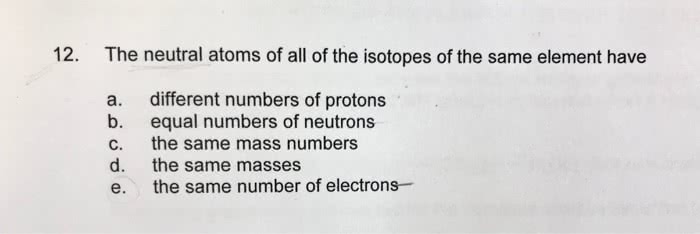If there are two samples of carbon, one of carbon-12 and one of carbon-14. Do the two isotopes behave differently in chemical reactions at all? Since chemical reactions are based primarily on electrons and electron shells, I don’t imagine that there would be a huge difference, but that is not the same as no difference.
Since I’m not quite sure what could be different about the isotope’s reactivity, interpret my question broadly. “Different” could mean forming certain compounds easier, or maybe a slightly decreased reaction rate in certain cases (even if the decrease is less than 1%).
Isotopes are atoms of the same element that: a. Have different numbers of electrons. Have different numbers of protons. Have different numbers of neutrons. Isotopes of an element have the same atomic number, but different mass numbers. The atomic number, when represented along with the symbol of an element, is shown as a leading subscript. The mass number is shown as a leading superscript. Since the element symbol implies an atomic number, the latter is often dropped, and an isotope as commonly. Isotopes of the same element must have the same number of neutrons. Isotopes of the same element must have different numbers of neutrons. A neutral atom of 37.
Since the two isotopes have different masses, do the atoms have different sizes? If they do, then it most likely has an effect in chemical reactions.
This question isn’t solely about carbon specifically. It is about isotopes in general.
4 Answers
Frank mccourt angela's ashes interview. So, at the most basic level, the main difference is the energies of the bonds themselves, especially the vibrational energies. Since isotopes are either slightly larger or smaller than the standard atom, bonds to them vibrate at slightly different energies then they would if it were to a standard atom, and this changes the energy of the bond, and makes a difference in terms of cleavage and formation energies. This can actually be fantastically useful in determining chemical mechanisms, and is known as the ‘kinetic isotope effect’, usually primary and secondary isotope effects.
Hydrogen is, naturally, the one that is used most often in these types of experiments, as the isotopes are essentially double and triple the mass of the standard atom, but these effects are still seen for heavier atoms, though you naturally need better and better equipment to tell the difference.
Yes, a Ca^-2 is showing that it has to more electrons that normal so it could bond with C and satisfy the octet. 2Ca normal with carbon would satisfy octet
@SaveTheRhinos Those aren’t the sort of isotopes that I was talking about. Two different isotopes of a specific element are two forms of the element that have a different number of neutrons. Watch mtv roadies. This does not affect the number of protons or electrons.
The Wikipedia article on isotope discusses the kinetic isotope effect mentioned above by @BhacSsylan. ”..heavier isotopes tend to react somewhat more slowly than lighter isotopes of the same element.”
The same article also notes that ”..isotopologues will have different sets of vibrational modes. Since vibrational modes allow a molecule to absorb photons of corresponding energies, isotopologues have different optical properties in the infrared range.”
Otherwise I don’t think there’s any chemical difference. Electron orbitals, which determine chemical bonding properties and atomic size, are indifferent to the mass of the nucleus & depend only on proton number.
Great Question :)
Answer this question


This question is in the General Section. Responses must be helpful and on-topic.
Learning Objectives
- Define isotope.
- Calculate the number of neutrons in an isotope when given atomic number and atomic mass.
Are all the members of the football team shown above identical?
They are on the same team and are all known by the same team name, but there are individual differences among the players. We do not expect the kicker to be as big as the quarterback. The tight end is very likely to weigh less than the defensive tackle on the other side of the ball. They play as a unit, but they have different weights and heights.
Isotopes
The history of the atom is full of some of these differences. Although John Dalton stated in his atomic theory of 1804 that all atoms of an element are identical, the discovery of the neutron began to show that this assumption was not correct. The study of radioactive materials (elements that spontaneously give off particles to form new elements) by Frederick Soddy (1877–1956) gave important clues about the internal structure of atoms. His work showed that some substances with different radioactive properties and different atomic weights were in fact the same element. He coined the term isotope from the Greek roots isos (íσος “equal”) and topos (τóπος “place”). He described isotopes as, “Put colloquially, their atoms have identical outsides but different insides.” Soddy won the Nobel Prize in Chemistry in 1921 for his work.
As stated earlier, not all atoms of a given element are identical. Specifically, the number of neutrons can be variable for many elements. As an example, naturally occurring carbon exists in three forms. Each carbon atom has the same number of protons (6), which is its atomic number. Each carbon atom also contains six electrons in order to maintain electrical neutrality. However the number of neutrons varies as six, seven, or eight. Isotopes are atoms that have the same number atomic number, but different mass numbers due to a change in the number of neutrons.
The three isotopes of carbon can be referred to as carbon-12 [latex]left(^{12}_6text{C}right)[/latex], carbon-13[latex]left(^{13}_6text{C}right)[/latex], and carbon-14[latex]left(^{14}_6text{C}right)[/latex]. Most elements naturally consist of mixtures of isotopes. Carbon has three natural isotopes, while some heavier elements can have many more. Tin has ten stable isotopes, the most of any element. The term nuclide refers to the nucleus of a given isotope of an element. A carbon atom is one of three different nuclides.
While the presence of isotopes affects the mass of an atom, it does not affect its chemical reactivity. Chemical behavior is governed by the number of electrons and the number of protons. Carbon-13 behaves chemically in exactly the same way as the more plentiful carbon-12.
Summary
- Isotopes are atoms that have the same atomic number, but different mass numbers due to a change in the number of neutrons.
- The term nuclide refers to the nucleus of a given isotope of an element.
- The atomic mass of an atom equals the sum of the protons and the neutrons.
Practice
Use the link below to answer the following questions: Live interior 3d pro free download.
- When was the term “isotope” first used?
- Are isotopes of an element chemically the same or different?
- How are radioactive isotopes used?
Review
- What does the term “isotope” mean
- Define “isotope.”
- What affects the chemical behavior of an atom?
- An isotope of yttrium has 39 protons and 59 neutrons. What is the atomic mass of that isotope?
- An isotope with an atomic mass of 193 has 116 neutrons. What is the atomic number of this isotope?
- An isotope of barium (atomic number 56) has an atomic mass of 138. How many neutrons are in the nucleus of this isotope?
Glossary
- isotope: Atoms that have the same number atomic number, but different mass numbers due to a change in the number of neutrons.
- nuclide: The nucleus of a given isotope of an element. A carbon atom is one of three different nuclides.
Isotopes Of The Same Element Have Different
Show ReferencesIsotopes Of The Same Element Have Different Quizlet
References
Isotopes Of The Same Element Have Different Chemical Properties
- Courtesy of Chief Photographer’s Mate Johnny Bivera, U.S. Navy. http://commons.wikimedia.org/wiki/File:Football_play_from_scrimmage.jpg.
